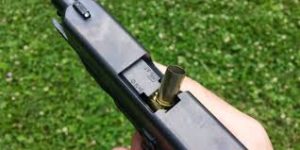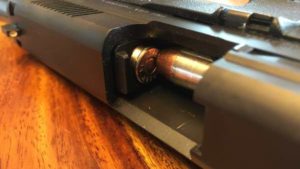There are 3 types of common malfunctions that can be remedied almost immediately. They are the:
Type 1 click no bang, no round in the chamber, misfire, etc
Type 2 malfunction stovepipe
Type 3 malfunction, double feed


Clearing Malfunctions
Sooner or later you will have a malfunction and knowing how to clear it and put your gun back into the fight could be the deciding factor as to whether you survive a violent, “use of deadly force” encounter.
The last thing you want is to hear a “click” when you expected a “bang” from your gun or to see a spent shell protruding from your slide, or your slide not closing because it is trying to feed a second round into an already loaded chamber.
The correct Type 1 (click with no bang)
It could be caused by a failure of the slide to pick up a new round after a shot has been fired. It could be a failure to fire where a new round has been chambered but failed to go off.
To correct a type 1 malfunction:
1, rap the magazine floorplate sharply to ensure that the magazine is fully seated into the firearm.
2, Rack the slide to the rear while simultaneously rolling the gun toward the right. This allows the clearing of a spent case from the gun. Let go of the slide and allow it to slam home as it strips a new round from the magazine and feeds it into the chamber.
3, regain a proper grip and continue to shoot.
To correct a type 2 malfunction: (stovepipe)
These are evident as the spent cartridge has been caught in the slide during the ejection cycle and is now sticking up resembling a stovepipe.

1, Rap the magazine to ensure it is seated
2, Rack the slide all the way to the rear
3, Let go of the slide and allow it to slam shut.
So far, these steps are the same as the method for clearing a type 1 malfunction. However, if your gun will allow it, and many do, you can simply slide your hand briskly along the slide sweeping the empty casing free and allowing the slide to close. As I said this works with some guns. You need to set up a stovepipe with a round fed into the chamber and try it. If your gun allows it, this is the fastest way to clear a type 2 malfunction or stovepipe.
These first two can also be caused by “limp wristing or failing to hold the gun tightly enough for the recoil to allow the slide to receive sufficient energy to operate as intended. Newton’s law says that for every action there is an equal and opposite reaction as some of the energy is absorbed by your wrist during recoil, thus depriving the gun of some of the energy needed to operate properly.. Limp wristing does not allow the equal part of the reaction to allow the slide to move far enough to the rear to strip the next round from the magazine or in most cases to even extract and eject the spent case properly. Limp wristing can be cured with a proper grip. Your wrists and arms should be locked to provide proper resistance to recoil.
To Correct a type 3 malfunction (double feed)
Double Feed

The double feed is as the name implies two rounds attempting to occupy the same space. This obviously does not work very well. It is characterized by one round already being in the chamber while a second is stripped from the magazine and is also attempting to feed into the same chamber. The procedure for clearing a type 3 malfunction is a bit more involved and time-consuming than the previous types. It should therefore, if possible, be performed behind suitable cover.
The procedure is as follows:
1, Lock the slide to the rear and remove the magazine. ( this may require a stronger tug than normal) retain the magazine in hand if possible by pinching between the ring and pinky finger.
2, rack the slide vigorously to the rear three times.
3, Re-insert the magazine (or insert a new one as necessary)
4, Rack the slide to the rear, regain the firing grip and continue shooting.
Each of the above conditions can be “set up” on the range and practiced.
To set up a type 1 malfunction, randomly insert dummy rounds into your magazine with live rounds and shoot to failure, clear, and resume fire.
Malfunction, or Immediate Action Drills
Type 1 click no bang, no round in the chamber, misfire, etc (tap, rack, roll)
Type 2 malfunction stovepipe (sweep the slide)
Type 3 malfunction, double feed ( slide lock, mag out, rack 3 times, reload) ( retain mag if possible) (try to find cover before executing the clearance)
Clearing Malfunctions
Sooner or later you will have a malfunction and knowing how to clear it and put your gun back into the fight could be the deciding factor as to whether you survive a violent, “use ofdeadly force” encounter.
The last thing you want is to hear a “click” when you expected a “bang” from your gun or to see a spent shell protruding from your slide, or your slide not closing because it is trying to feed a second round into an already loaded chamber.
The correct a Type 1 (click with no bang)
It could be caused by a failure of the slide to pick up a new round after a shot has been fired. It could be a failure to fire where a new round has been chambered but failed to go off.
To correct a type 1 malfunction:
1, rap the magazine floorplate sharply to ensure that the magazine is fully seated into the firearm.
2, Rack the slide to the rear while simultaneously rolling the gun toward the right. This allows the clearing of a spent case from the gun. Let go of the slide and allow it to slam home as it strips a new round from the magazine and feeds it into the chamber.
3, regain a proper grip and continue to shoot.
To correct a type 2 malfunction: (stovepipe)
These are evident as the spent cartridge has been caught in the slide during the ejection cycle and is now sticking up resembling a “stove pipe”.
1, Rap the magazine to ensure it is seated
2, Rack the slide all the way to the rear
3, Let go of the slide and allow it to slam shut.
So far, these steps are the same as the method for clearing a type 1 malfunction. However, if your gun will allow it, and many do, you can simply slide your hand briskly along the slide sweeping the empty casing free and allowing the slide to close. As I said this works with some guns. You need to set up a stovepipe with a round fed into the chamber and try it. If your gun allows it, this is the fastest way to clear a ttype 2 malfunction, or stovepipe.
These first two can also be caused by “limp wristing or failing to hold the gun tightly enough for the recoil to allow the slide to receive sufficient energy to operate as intended. Newtons law says that for every action there is an equal and opposite reaction as some of the energy is absorbed by your wrist during recoil, thus depriving the gun of some of the energy needed to operate properly.. Limp wristing does not allow the equal part of the reaction to allow the slide to move far enough to the rear to strip the next round from the magazine or in most cases to even extract and eject the spent case properly. Limp wristing can be cured with a proper grip. Your wrists and arms should be locked to provide proper resistance for recoil.
To Correct a type 3 malfunction (double feed)
The double feed is as the name implies two rounds attempting to occupy the same space. This obviously does not work very well. It is characterized by one round already being in the chamber while a second is stripped from the magazine and is also attempting to feed into the same chamber. The procedure for clearing a type 3 malfunction is a bit more involved and time consuming than the previous types. It should therefore, if possible, be performed behind suitable cover.
The procedure is as follows:
1, remove the magazine. ( this may require a stronger tug than normal) retain the magazine in hand if possible by pinching between the ring and pinky finger.
2, rack the slide vigorously to the rear three times.
3, Re-insert the magazine (or insert a new one as necessary)
4, Rack the slide to the rear, regain firing grip and continue shooting.
Each of the above conditions can be “set up” on the range and practiced.
To set up a type 1 malfunction, randomly insert dummy rounds into your magazine with live rounds and shoot to failure, clear, and resume fire.
To set up a type 2 malfunction, take an empty shell casing and insert the base into the ejection opening and easy the slide forward catching the case in the “stovepipe” condition.
To set up a type 3 malfunction is a bit more difficult. With a dummy round in the chamber, and the magazine inserted, bring the slide to the rear and hold open while inserting a dummy round between the slide and dummy round in the chamber, ease the slide forward capturing the round in the double feed position.
Each of these should be practiced regularly so that should the time come you can execute each maneuver without thinking about steps etc. Cover is your friend use it if it is available.
To set up a type 2 malfunction, take an empty shell casing and insert the base into the ejection opening and easy the slide forward catching the case in the “stovepipe” condition.
To set up a type 3 malfunction is a bit more difficult. With a dummy round in the chamber, and the magazine inserted, bring the slide to the rear and hold open while inserting a dummy round between the slide and dummy round in the chamber, ease the slide forward capturing the round in the double feed position.
Each of these should be practiced regularly so that should the time come you can execute each maneuver without thinking about steps etc. Cover is your friend use it if it is available.
If you are not practicing these malfunction drills frequently, how do you expect to do it under incoming fire? These drills need to be reactive, they are called “immediate action drills” for a reason. Until you have corrected the malfunction, you are in a gunfight, knife fight, getting pummeled with a baseball bat, a rock, or whatever else your assailant uses, and all you have is a very short club.
There are no guarantees in a “deadly force encounter”, but, don’t die being stupid! Practice, practice,
practice.